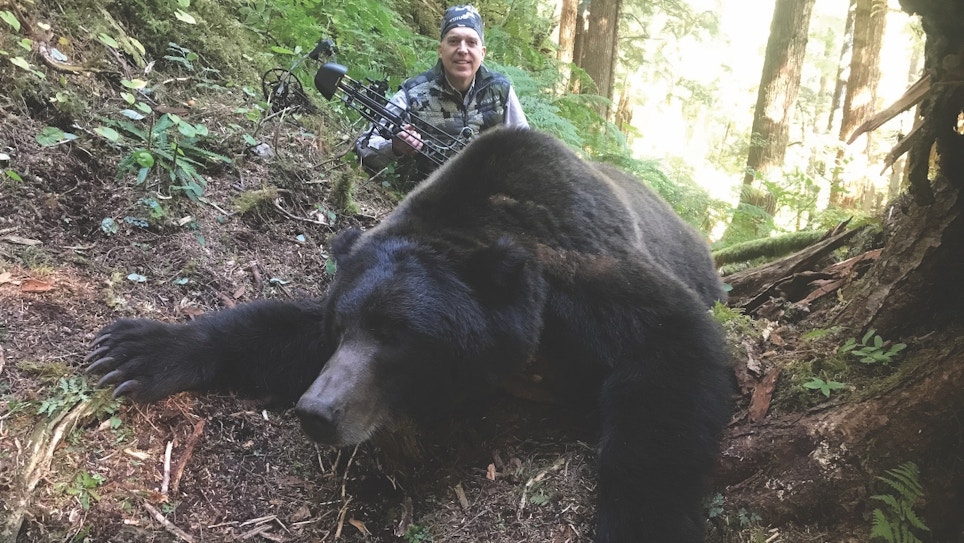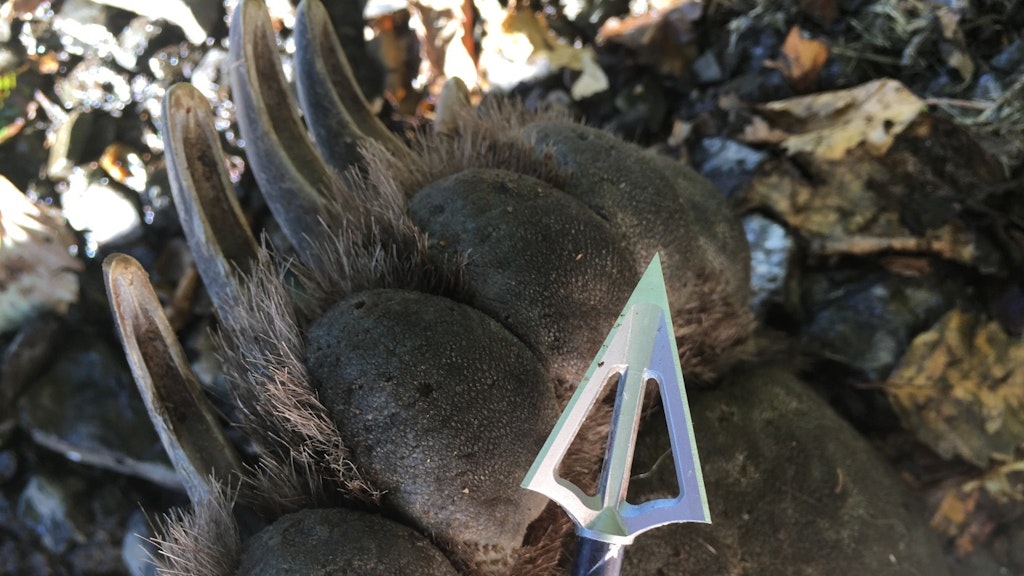Without a doubt, the apex predator in North America is Ursus arctos horribilis, the grizzly bear. The name translates literally as “horrible bear.” And the coastal brown bear, the largest of the grizzlies, tops them all. Except for the polar bear, they are the largest carnivore in North America. With weights that can approach 1,500 pounds, the strength of Superman, speed of the fastest racehorse and the nastiest of dispositions, it’s a wonder why anybody would want to hunt them with a bow and arrow.
Yet there I was, back in mid-September 2018, on southeast Alaska’s Admiralty Island assisting two Alaska Master Guides who both have had serious encounters with brown bears in the past. Scott Newman was once mauled badly by a wounded bear and has had many other close encounters. And Jim Boyce, a former navy SEAL with two Vietnam combat tours under his belt, has had to fend off charging bears more than once. I worked as an assistant guide for Jim for many years, and both with him and hunting on my own, I’ve had my own “excitement” hunting the big bears.
The clients were a pair of bowhunters with zero dangerous game experience. Hunting Admiralty Island, located in the heart of the Tongass National Forest, made the odds good that the pair were going to get their money’s worth when it came to close encounters with fang and claw. Admiralty — the seventh largest island in the United States — is home to approximately 10 percent of Alaska’s entire brown bear population, with a density of almost one bear per square mile. With less than 700 year-round residents, brown bears outnumber humans here by a near 3:1 ratio.
Fall Hunting Strategies
The strategy is simple. Fall bear season opens September 15, and you hike up one of the island’s many jungle-like streams, which are where brown bears congregate to gorge themselves on the remnants of the year’s salmon runs. In the mornings, the prevailing winds generally flow downstream, so you carefully hike upstream with the wind perfect, glassing as you go. You might spot bears or find a pool with lots of fish and bear sign, then set up and wait.
Hunting the first few days of the season is critical. Why? Because southeast Alaska is a rainforest. Petersburg, where our hunt was based, averages 109 inches of rain each year, with an average September rainfall of 13.66 inches. Average temperatures range from 44 to 57 degrees Fahrenheit. The first couple weeks of September are reasonably dry, but when the first of the fall’s monsoon rains begin sometime mid-month, the rivers rise rapidly, washing the last of the dead salmon carcasses out into the ocean. When the fish are gone, the bears — especially the old, mature boars — spend their time digging tidal flat roots and retreat into the thick old growth forest searching for other food sources as they try to pack on the pounds in anticipation of their winter hibernation.
One challenge we faced was that the 2018 salmon run in most of Alaska, including southeast, was the worst in at least a decade. According to the Alaska Department of Fish and Game (ADFG), the run produced only 35 percent of the predicted sockeye run, 37 percent of the predicted coho run, 33 percent of the predicted pink salmon run and 89 percent of the predicted chum salmon run. That meant rivers that should have been choked with fish held handfuls. And when salmon are scarce, there will be few — or no — brown bears on the streams.
For bowhunters Lee Franklin of Alabama and hunting buddy Doug Bing of Montana, this was not good news at all. The good news was that the weather — clear skies and light winds — was perfect for hunting.
Day One: Success!
Hunting with Scott and assistant guide Craig Bisson, Lee Franklin did not have to wait long. Working up a beautiful stream, the trio encountered no less than 16 brown bears before 10 a.m. But when a big, beautiful, nearly coal-black boar started coming down the stream right at them they set up, and with the bear just 12 yards away, Lee made a killing shot. In less than a half-day he had achieved his dream with a bear whose hide squared 8-feet, 6-inches, and had an estimated body weight of 750 pounds.
For Jim, Doug and me, things took a bit longer — but not because we didn’t have early opportunities.
We weren’t on our stream for more than 30 minutes when Jim glassed up a big boar splashing about a deep pool. We got crosswind, slithered our way upstream, then watched the show for more than an hour. Despite Jim’s advice — “That is a really, really big boar, Doug!” — Bing chose not to take a shot. Later, looking at the pics, there’s no doubt this was by far the biggest bear we found during the hunt. But as Doug later admitted, “I had the first morning jitters and didn’t want to make a mistake.” The mistake was not taking Jim’s advice.
OK, no problem, let’s keep hunting. By midmorning we backed out and tried another nearby stream, which had zero fish and zero bear sign. So that evening we went back to our pool to see what might shake out. We were treated to quite a show, with four brown bears working the pool — but no real shooters.

Day Two: We’re Surrounded!
The next morning Jim, Doug and I we were back at the same pool and saw several more bears before deciding to slip around them and work upstream. After a mile of no more salmon, it was obvious that all the action would be at the first morning pool, so we were back in position three hours before dark. And what a show! We had no less than nine bears between 25 and 100 yards from us on three sides, including three studs — but none gave Doug a shot. Just before dark a big bear walked within 10 steps from where we were hidden in the brush, heading right for us. Boyce woofed at it, and thankfully it bounded off in the other direction.
We retreated to the mother ship to regroup and change our Fruit of the Looms.
Day Three: Insanity
The morning of day three we decided to change it up a bit and hike up the same creek where Lee had taken his bear, figuring if we didn’t find what we wanted we could go back to our other spot for the evening hunt. It wasn’t necessary.
Craig Bisson led the way, because he had been up this stream before. Within 2 miles we had seen 11 brown bears, including a sow with two big cubs; she puffed herself up and created a 20-minute stand-off at 50 yards that had everyone’s hackles on red alert. Would she charge? Fortunately, she did not. After the bears thankfully moved off, we eased around the next corner — and there he was!
It took only a brief look for Boyce to hiss, “Shooter!” The bear was fishing in a pool 100 yards upstream, so we eased up to a downed tree across the river and waited to see what it might do. He caught and ate a salmon, and then, finding no more fish, walked downstream right at us. When he was broadside at 28 yards Boyce woofed and stopped him, and Doug let an arrow fly. It hit the bear a bit high and back, but instead of running off he stood there, stunned, miraculously giving Doug another shot. That arrow hammered him, and the bear went only 20 steps before piling up on the edge of the stream bank. Just like that, Bing has a dandy black boar with a hide that squared 8-feet, 9-inches, with an estimated body weight of 800 pounds.
A Special Hunt
When I was an Alaskan resident I hunted brown bears a lot, sometimes on my own with both rifle and bow, and often as an assistant guide working with Jim Boyce. A trophy brown bear will be 10 years of age or more, with some reaching their mid-20s. (The oldest I personally killed was aged by the Alaska Department of Fish & Game at 21 years.) Creeping up a southeast Alaska salmon stream filled with big bears is one of the most exhilarating hunting experiences on the continent.
I can’t wait to do it again.
Hunting brown bears in Alaska: Lots of rules
In Alaska GMU 4, hunters are allowed to kill one brown bear every four years., and there are both spring and fall seasons. Nonresidents are required to hire a licensed hunting guide, who is allocated a limited number of brown bear permits each year. A nonresident hunting license ($160) and brown bear locking tag ($1,000) are required. All brown/grizzly bears must be “sealed” by an official ADFG “sealer” within 30 days of the kill.
Bowhunters must use a compound bow of at least 50-pound draw weight and an arrow at least 20 inches long weighing a minimum of 300 grains. Fixed-blade, replaceable-blade and mechanical broadheads are all legal if no blades have barbs. An IBEP (International Bowhunter Education Program) card is required if you were born after Jan. 1, 1986, and the hunt occurs in an archery-only season — not the case on this hunt. Crossbows are legal as well, but as of July 1, 2018, hunters using a crossbow during any hunt in any unit must complete an Alaska Department of Fish & Game approved crossbow certification course. Traditional archery equipment is also legal. For rifle hunters, a .300 magnum is the minimum to consider. The .375 H&H Mag., .458 Win. Mag. and similar cartridges are popular. The key is being able to shoot it well.
Spring brown bear season for nonresidents in GMU 4, which encompasses Admiralty, Baranof and Chichagof islands, usually runs May 15-31, and the fall season is open September 15 - December 31. Nonresidents are required by law to hire a registered guide/outfitter to hunt grizzly and brown bears. Because permits are limited and demand is high, so is the cost — boat-based hunts will run tens of thousands of dollars. More general information is available from the Alaska Department of Fish and Game, www.adfg.alaska.gov. A list of licensed guides and outfitters can be found from the Alaska Professional Hunters Association, at https://www.alaskaprohunter.org/.







